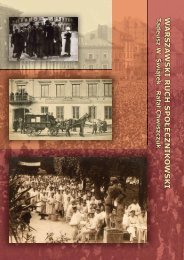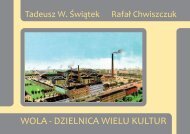Create successful ePaper yourself
Turn your PDF publications into a flip-book with our unique Google optimized e-Paper software.
Książka telefoniczna na rok 1939. Ze zbiorów R. Chwiszczuka.<br />
A phone book from 1939. From R. Chwiszczuk’s collection.<br />
55<br />
surrounding the Warsaw Ghetto were<br />
built. During 20-25 October 1940, ethnic<br />
Poles living in the designated area of<br />
the Warsaw Ghetto were evicted and<br />
replaced by about 140,000 Jews from<br />
other areas of Warsaw. By the 15th November<br />
1940 the Warsaw Ghetto had<br />
been completely walled-off .<br />
On 22 February to 15 September<br />
1942, from the Square near Umschlagplatz<br />
(Stawki Street), Jews were transported<br />
in cattle freight wagons, to their<br />
deaths at Treblinka. However, even<br />
after the deportations, the Ghetto was<br />
still home to 55,000 Jews of which<br />
20,000 were illegal inhabitants.<br />
From 18th January 1943, the deportations<br />
abruptly resumed. However deportations<br />
ceased when Jewish armed<br />
units began to resist. Jewish fi ghters<br />
had already harassed German units<br />
for some time. On 19th April 1943, SS<br />
Units entered the walled Ghetto and<br />
the Uprising had started. Fighting concentrated<br />
mainly in the northern areas<br />
of the Ghetto, from Gęsia Street (today<br />
Okopowa Street), to the northern outskirts,<br />
as well as the streets of Nowolipki,<br />
Karmelicka, Leszno, Żelazna<br />
and Smocza. Fierce fi ghting lasted for<br />
nearly a month. When an SS unit overran<br />
a street, they systematically leveled<br />
the buildings, brutally killing everyone<br />
they found. The last of the Jewish fi ghters<br />
escaped onto the Arian side, where<br />
they were helped the Polish Socialist<br />
Partisan group among others. They<br />
would eventually take part in the failed<br />
Warsaw Uprising a year later. On 16th<br />
May the butcher of the Warsaw Ghetto,<br />
Jürgen Stroop, instigated the destruction<br />
of the Great Synagogue („Wielką<br />
Synagogę”) on Tłomackie Street. The<br />
Jewish District north of Leszno Street<br />
(Solidarności Street today) was entirely<br />
fl attened. In 1945 it was estimated that<br />
in the Jewish Ghetto (present day Muranów)<br />
lay three million m 3 of rubble.<br />
On the 1st of January 1946, the<br />
once thriving Warsaw Jewish community<br />
of over 300,000 was reduced to<br />
mere 18,000. During communist times<br />
offi cial anti-Semitism varied depended<br />
on the political climate. But in 1968 the<br />
now infamous speech by Władysław<br />
Gomółka, culminated in an anti-Semitic<br />
witch-hunt, which drove many Jews<br />
from Poland, some 20,000 in total.<br />
In 1978, Izaak Baszewis Singer<br />
(1902-1991) the Polish Jewish writer,<br />
and one time resident of Warsaw, received<br />
the Nobel Prize for literature; a<br />
fi tting tribute for someone who through<br />
his books kept the memory alive of the<br />
once proud Jewish community in Warsaw<br />
and Poland.<br />
After the fi rst free Polish elections,<br />
in 1989, Pinchas Menachem Joskowicz<br />
became Poland’s Chief Rabbi, residing<br />
in Warsaw. In 1997, Polish Jews were<br />
granted restitution to Jewish property<br />
once owned by Warsaw’s Jewish Religious<br />
Community Organization (Gmina<br />
Wyznaniowa Żydowska). The National<br />
Jewish Organization has eight branches,<br />
with 500 members. Its main Jewish Synagogue<br />
is the Nożyks’ Jewish Orthodox<br />
Synagogue on Twarda Street, Warsaw;<br />
the only Synagogue in Warsaw that<br />
survived devastation of World War II.




